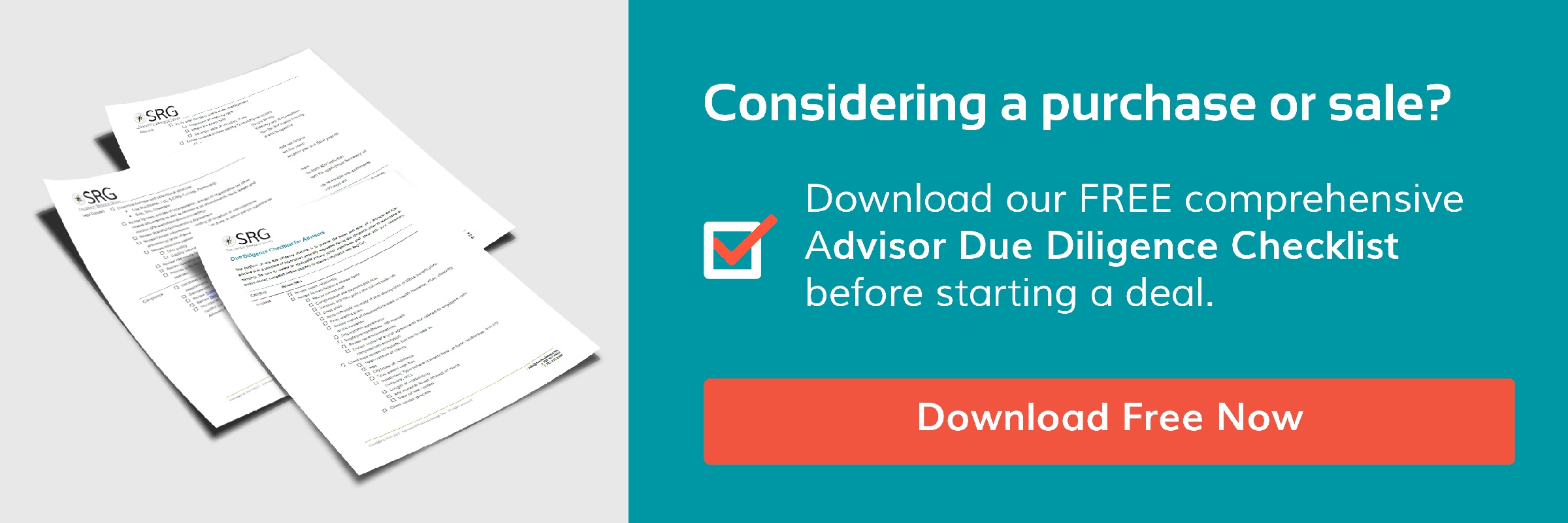What Is the Due Diligence Process?
With any merger or acquisition (M&A), there is a level of risk and uncertainty involved with every deal. As a buyer, one of the best ways to mitigate this risk is to get a full understanding of the target company being considered. This is highly important because once a transaction is completed, any issues that the selling company has been experiencing are now the buyer’s responsibility. This is where the due diligence phase comes in.
The due diligence process should officially begin once a letter of intent is signed by both parties. At this point we know that both the buyer and seller are interested in brokering a deal, but now is the time to be transparent with relevant and requested information. The due diligence phase is a comprehensive assessment of the books and records of the target company prior to closing a merger or acquisition (M&A) deal.
During this phase, the buyer will analyze the seller’s financials, contracts, customers, liabilities, compliance, corporate records, and anything else that is pertinent to the deal and its valuation. The intent of going through the due diligence process is to determine the overall viability of a transaction, for the buyer to feel fully informed regarding the seller’s operations, and for the buyer to have the confidence to move forward with closing the deal.

How Long Does the Due Diligence Process Take?
Since the information needed is only accessible from the selling company themselves, they are responsible for providing due diligence information to the buyer. A motivated seller should begin putting together these resources as soon as they decide to begin marketing their business for sale. In many cases, however, the organization of due diligence documentation may not have begun until after a letter of intent had been signed by both parties. This pre-preparation (or lack thereof) can impact this phase’s timeline.
The amount of time that the due diligence document will take is dependent on a number of variables. Among them is the complexity of the seller’s business, the availability to have a dedicated resource on the task, and how motivated they are to compile this information in short order. It is not uncommon for it to take two to three months to compile a full due diligence report. Regardless of the amount of time it will take, this is a pivotal part of the M&A process and integral to closing the deal. Until due diligence documentation has been provided and thoroughly reviewed, it is not wise to move forward with any M&A transaction. If a deal were to proceed without due diligence, the buyer would be taking on a significant amount of unnecessary risk.
What Is a Due Diligence Checklist?
Because each organization is different and will have its own method for approaching this information-gathering process, it is important that they develop their own checklist for due diligence. Checklists for due diligence will provide buyers with an organized method to analyze a target company beyond their basic financial statements and allow their business to be viewed holistically. This checklist is important to have because it ensures that relevant information does not go overlooked during the due diligence process. When conducting due diligence during the mergers and acquisitions process, here are common assessments worth requesting (note that the suggestions reflected below are not comprehensive, but rather a starting point):
- Organization Overview: To get an overall understanding of a company, an overview with supporting documents is beneficial. This includes the business registrations and official paperwork, annual reports, organizational charts, shareholder information, subsidiaries of the company, and an overview of their presence in different states and countries, and more.
- Sales, Customers, and Revenue Streams: Since the health of a business and its potential for growth are directly tied to its customers and revenue streams, it is important to have a clear understanding of this area. Financial records will tell part of this story, but it is also important to get more information on details around sales patterns, customer loyalty, cost to acquire a new customer, estimated lifetime value of a customer, and who the most important customers are. A buyer will also want to get a sense of the key relationships or partnerships that have an impact on sales and what the status of each contract is.
- Products and Services: Information on the product and services the target company offers (as well as others that may be in development) should be gathered. Market research or customer feedback that has been conducted for these offerings should also be collected. Having a sense of the profitability and cost of each offer will help determine the ongoing viability of each product.
- Material Contracts: Review all official contracts, agreements, and arrangements that may impact the business or its subsidiaries.
- Financial Information: Perhaps one of the most important portions of the checklist of due diligence are the financial records, as financial performance is a primary indicator of the potential for success and continued growth in any M&A deal. Closely review recent annual and quarterly financial statements, projections, outstanding debts, and how they are managing their working capital. Note that these financial statements should be audited and official. If the business has multiple revenue streams, each one should be reviewed individually to determine their value and risk factors.
- Tax Information: Collecting tax information will provide an indication of how they have leveraged the tax process in the past. This will also help to identify any number of red flags related to their financial situation. At least three years’ worth of a company’s tax returns, including federal, state, local, and foreign taxes (if relevant) should be obtained. The buyer should also request employment tax filings, excise tax filings, and tax settlement documents from the same time period.
- Insurance Coverage: Get a sense of their insurance situation by reviewing claims from the past three years.A review of current insurance coverage can help determine what is covered and if there are any gaps that may need to be addressed.
- Real Estate and Other Physical Assets: Copies of any deeds, rental agreements, mortgages, title policies, zoning approvals, or other ownership documents should be collected. This will demonstrate what real estate is owned by the business in review. In relation to real estate assets, physical assets in the form of machinery and equipment (owned, rented, or leased) that are also included should be listed. It is also helpful to request a summary of annual expenses related to the maintenance of all real estate and physical assets.
- Antitrust and Regulatory Issues: To determine if there have been any previous regulatory or antitrust issues with the business, a list of all such issues should be requested. A business should consider reviewing antitrust laws to verify that the M&A purchase of this business will not result in any additional antitrust issues.
- Litigations: Taking on an existing business means taking on its legal issues as well. A list of pending and past litigations, past settlements, and current claims against the target company should be provided, as they may persist or still be relevant after a transaction is completed.
- Information Technology Concerns: As companies have modernized, the emphasis on information technology has continued to grow. A due diligence checklist should account for a full list of software used by the company along with licensing documentation. It is also helpful to know what safeguards they have in place for damaged equipment or system crashes. Financial impacts to be aware of here would be any ongoing fees for software used, technology upgrades and maintenance, and any outsourcing agreements with IT companies or contractors.
- Outsourced Contracts: A list of all independent contractors the business has worked with for at least the last three years should be requested. This will allow a buyer to reconnect with professionals who have familiarity with the target business. This includes roles such as consultants, lawyers, accountants, or freelancers.
- Employees and Benefits: While it will likely be difficult to retain all employees after mergers and acquisitions, the buyer needs to be able to make informed decisions on how to proceed with the people that are involved in the business being purchased. At a base level, it is important to receive a list of all employees, their current positions, years of service, and their compensation. An organization chart that provides a visual of how teams are structured will be very useful as well. A copy of the employee handbook should be requested to provide a comprehensive overview of employee expectations as well as their benefits structure.
- Intellectual Property: While sometimes overlooked, IP rights can be an incredibly important and valuable part of some mergers and acquisitions. This includes patents, trademarks, copyrights as well as any registered trade secrets, processes, or methods that are unique to that business.
- Licenses and Permits: The target company should be in compliance with their industry’s regulatory factors. Copies of federal, state, and local licenses, permits, and consent forms should be present. Documents related to any past regulatory issues should be obtained so the buyer is able to contextualize the issues that the target company has had to deal with.
- Publicity: Articles, press releases, and media coverage about the business from the past three years should be requested. Apart from understanding the company history, it is important to see how the business and its announcements have been perceived in the past. This gives the buyer the potential to learn from previous mistakes or address customer or community feedback confidently moving forward.
Depending on the M&A transaction being considered, the due diligence process and the associated checklist may be very different. While the categories above are a great place to start, a buyer will need to tailor their requests based on the specific business and its related industry. They may also want to include a list of specific questions for the business to answer if the related documents do not seem to tell the whole story. While the categories above are a great place to start, there are consultants and teams who can craft a custom due diligence checklist and manage this phase from start to finish.
Conclusion
The due diligence process allows for transparent information sharing to help buyers make informed decisions in M&A deals. This will help the buyer assess the seller’s business as a whole, including all of its challenges and opportunities. This will help to determine if the deal at hand is in the best interest of the buyer. A robust checklist will ensure that the due diligence process leaves no stone unturned. No matter what surprises are uncovered during the due diligence phase, the buyer will be glad to have received that information prior to closing the deal.




